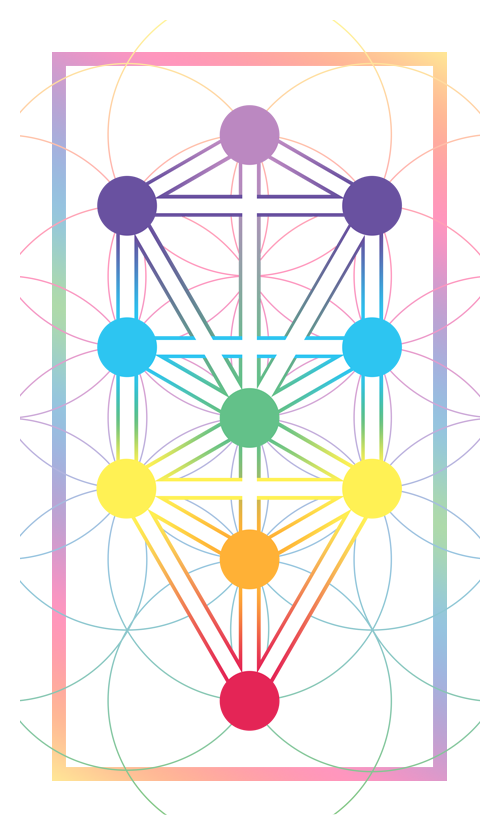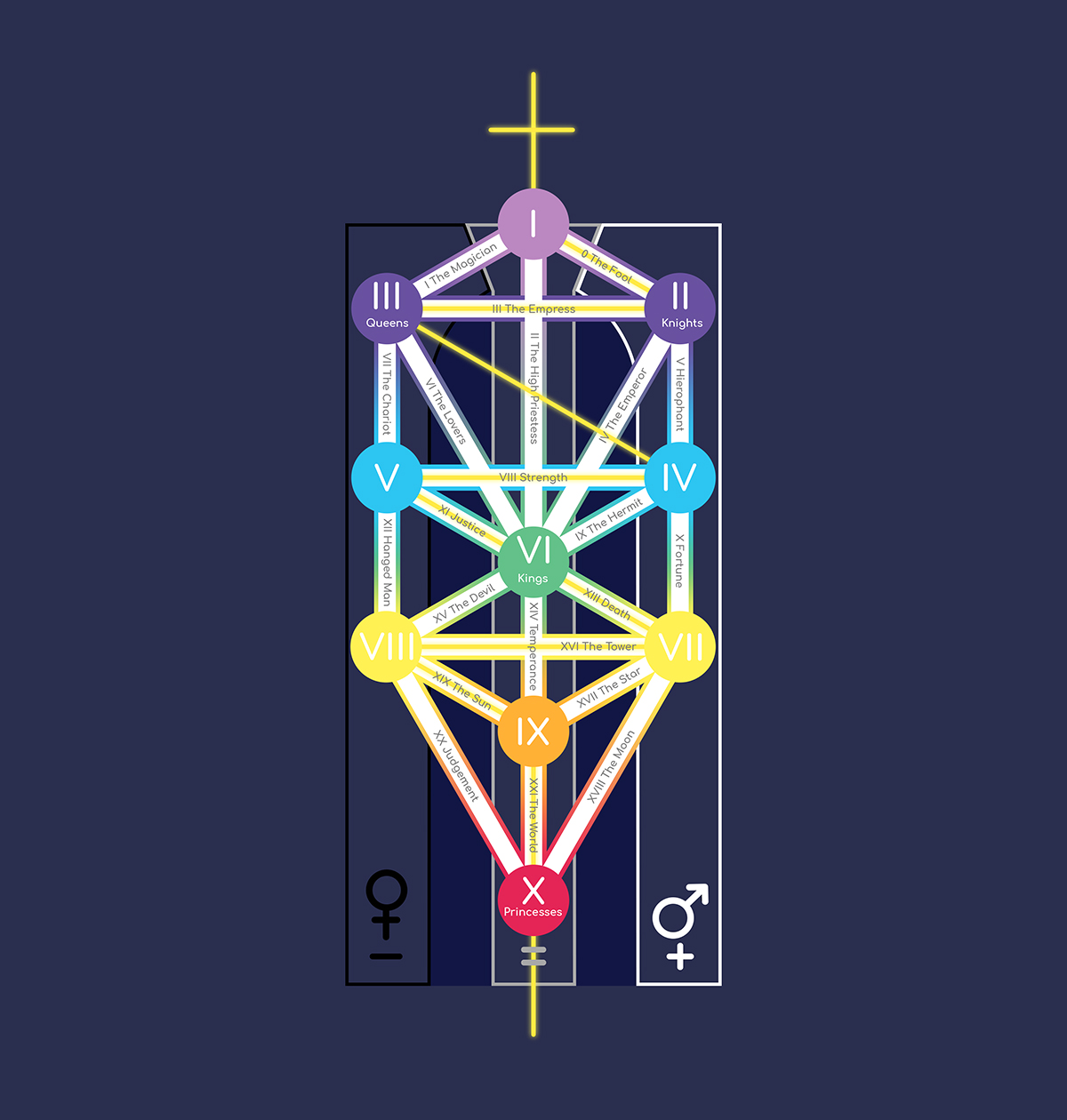The Tree of Life
Introduction
The Tree of Life is a diagram of human consciousness that is thought to have been originally conceived as far back as the 9th century B.C. There are many schools of thought that have studied and adopted it into their belief systems, but the one it is most often associated with is Kabbalah. In Tarot, the Tree of Life serves as the blueprint to the meanings of the cards and how they are connected. Conversely, the cards are considered to be the keys to the Tree of Life. For this reason, much deeper meaning can be found in the cards when their position on the tree of life is considered.
What is Kabbalah?
Kabbalah is a school of thought that seeks to explain the relationship between our universe, God, and infinity by studying the esoteric, hidden meaning of the Torah. It originated from Jewish mysticism and has since been adapted to traditions of Christianity (Cabala) and Hermetcism (Qabalah).
By design, Kabbalah is a difficult subject to wrap ones head around. It is the secret knowledge guarded by the High Priestess, not intended for the uninitiated and obscured by veiled meanings. Like astrology, it can be a fun puzzle to attempt to solve, but everyone sees it a little differently.
A note on Religion, Pop Culture, and the Collective Unconscious
As much as I want to keep these cards as secular as possible, it is impossible to fully express their meaning without acknowledging certain religious symbolism, at least insofar as it pertains to the collective unconscious. Back in the day, religion was pop culture, in the same way pop culture is like religion today. In my opinion, a deck created in the modern era that used only universal pop culture references would be just as valid as one that uses mythology and religious symbolism as long as it was faithful to the energy of the cards. It’s all about what people can relate to and find meaning in. No matter what you believe in, the most important thing is to keep an open mind.
Tarot is unique in the way it combines elements from various schools of thought and creates an almost universal, syncretic belief system. That being said, I really believe that at the core of Tarot is the belief in oneself above all else.
The Breakdown
There is a lot of information contained in the tree of life, so I am going to attempt to break it down into parts to make it easier to digest. I won’t attempt to cover absolutely everything, just the facets that I think are most beneficial to tarot reading.
The 3 Pillars
The balance of opposites is a recurring theme in the symbolism of the cards, specifically in The High Priestess, The Hierophant, Justice, and The Chariot. In each, there is a purposeful representation of three pillars—light, dark, and neutral.
You may have noticed the J and B present on the High Priestess card in the Smith Waite deck. Those letters stand for the names of the pillars, Jachin and Boaz, which flanked the entrance to the temple of Solomon—the first temple in Jerusalem.
On the left is Boaz, the pillar of severity and the feminine principle, on the right is Jachin, the pillar of mercy and the masculine principle, and in the center lies the pillar of mildness which serves as the keystone between them.
The position of the cards on the pillars determines the polarity of their energy. This is the reason that some cards can feel more inherently negative or positive than others.
Diagram A - The 3 Pillars
The Lightning Flash
Diagram B - The Lightning Flash
In nature, the polarity between positive and negative forces creates electricity, and it does the same here.
This lightning flash is one of divine energy sent down to earth. It creates the path of enlightenment.
It can also be thought of as the path from creative energy to manifestation in terms of magic (or art.)
The lightning flash is also sometimes represented as a sword piercing down through the heavens.
The 10 Sephiroth
Along the path of the lightning flash are ten nodes called sephiroth(See diagram C below). They are orbs of divine emanation that represent ten states of consciousness. This is where the core numerological meaning of the cards of the minor arcana comes from.
The first sephirah is called Kether, or The Crown. It rests at the top of the tree with one half dipped into humanity and the other still resting in divinity. It is the connection between those two worlds and the root of consciousness. Like the Aces it is pure, infinite energy.
The second sephirah is called Chockmah, or Wisdom. It rests on the top of the right pillar and represents pure positive male energy. It possesses the will to create. In addition to the twos of the minor arcana, Knights are also associated to this sephirah. They are the fathers.
The third sephirah is called Binah, or Understanding. It rests on the top of the left pillar and represents pure negative female energy. It nurtures and gives form to the creative energy established in Chockmah. In addition to the threes of the minor arcana, Queens are also associated with this sephirah. They are the mothers.
The fourth sephirah is called Chesed, or Mercy. It possesses the spirit of benevolence. The fours of the minor arcana are attributed to this sephirah.
The fifth sephirah is called Geburah, or Severity. It possesses the spirit of judgment. The fives of the minor arcana are associated with this sephirah.
The sixth sephirah is called Tiphereth, or Harmony. It corresponds to the ego and the heart and possesses the spirit of mediation. In addition to the sixes of the minor arcana, Kings are also associated to this sephirah. They are the sons of the Knights and the Queens.
The seventh sephirah is called Nezach, or Triumph. It possesses the energy of the emotions and the artist. The sevens of the minor arcana are associated with this sephirah.
The eighth sephirah is called Hod, or Glory. It possesses the energy of the intellect and the scientist. The eights of the minor arcana are associated with this sephirah.
The ninth sephirah is called Yesod, or Foundation. It receives and purifies the energy from all the other sephiroth before transmitting it to the physical plane. The nines of the minor arcana are associated with this sephirah.
The tenth sephirah is called Malkuth, or The Kingdom. It represents stability and the physical world. In addition to the tens of the minor arcana, Princesses are attributed to this sephirah. They are the daughters of the Knights and Queens.
For more on numerology and Tarot check out this post.
The 7 Levels
There are 7 levels on the path of enlightenment that correlate to the 7 chakras. In this way, the tree of life also serves as map of the body.
The root chakra is represented at the base in red and the rest of the chakras follow up to the purple crown at the top. To see what cards correspond to each chakra you just have to consider their position on the tree.
Aces relate to the crown.
Twos and threes relate to the third eye.
Fours and fives relate to the throat
Sixes relate to the heart
Sevens and eights relate to the solar plexus.
Nines relate to the sacrum.
Tens relate to the root.
Diagram C - The 10 Sephiroth and the 22 Paths
The 22 Paths
There are 22 paths that connect the sephiroth and complete the form of the Tree of Life. These paths are the origin of the major arcana. The energy of those cards is created by the flow of energy between their two connecting sephiroth. So, while they fully embody their own number, deeper meaning can be found if you look at them this way too.
For example: Strength is the path between Chesed (mercy) and Geburah (severity). With that in mind, it makes sense that Strength would represent gentle persuasion and understanding.
The paths also correspond to the 22 letters in the hebrew alphabet, which is why those symbols appear on the cards in the hermetic tarot.
The 4 Worlds
The tree of life exists simultaneously within four different worlds. This is what accounts for the four suits of the minor arcana. The stories that unfold within the minor arcana can be thought of as the same journey occurring in four different realities.
Atziluth: The world of Emanation—corresponds to fire and the suit of wands.
Briah: The World of Creation—corresponds to water and the suit of cups.
Yetzirah: The world of Formation—corresponds to air and the suit of swords.
Assiah: The world of Manifestation—corresponds to earth and the suit of pentacles.
The Flower of Life is sacred geometry that the Tree of Life can be found in. I chose to use it to represent the four worlds because of the way the individual circles intermingle to create one whole.
The Serpent
Just as the lightning flash represented the descent of divine energy to earth, the serpent represents the ascent. It climbs the 22 paths on the journey of redemption told by the major arcana.
The Whole Picture
The Tree of Life serves as a reminder that there is nothing arbitrary about the symbolism of the Tarot. It rose from the ancient depths of human consciousness and will continue to be relevant throughout the reign of humanity. The cards connect us to the past, present, and future, as well as to the universe, ourselves, and each other.
This is just a general overview of a very dense topic. If you are interested in delving deeper, The Complete Guide to the Tarot by Eden Gray has an in depth chapter on this subject (see resources) and there are many other books and web resources dedicated to it.
I’ve added a page for this diagram to reside on so you can return to it whenever you need to. It can be found here.






